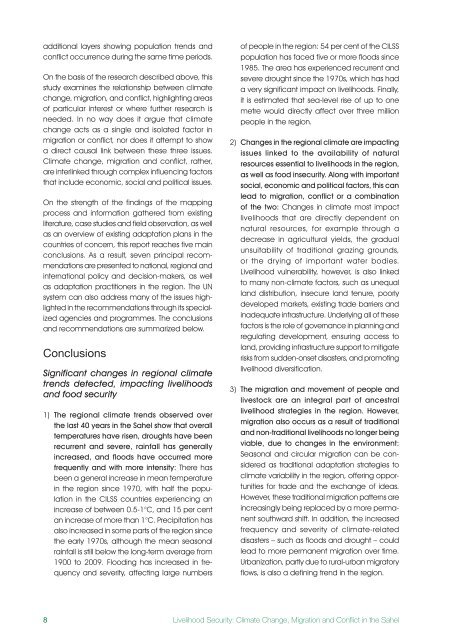Livelihood Security: Climate change, conflict and migration in - UNEP
Livelihood Security: Climate change, conflict and migration in - UNEP
Livelihood Security: Climate change, conflict and migration in - UNEP
Create successful ePaper yourself
Turn your PDF publications into a flip-book with our unique Google optimized e-Paper software.
additional layers show<strong>in</strong>g population trends <strong>and</strong><br />
<strong>conflict</strong> occurrence dur<strong>in</strong>g the same time periods.<br />
On the basis of the research described above, this<br />
study exam<strong>in</strong>es the relationship between climate<br />
<strong>change</strong>, <strong>migration</strong>, <strong>and</strong> <strong>conflict</strong>, highlight<strong>in</strong>g areas<br />
of particular <strong>in</strong>terest or where further research is<br />
needed. In no way does it argue that climate<br />
<strong>change</strong> acts as a s<strong>in</strong>gle <strong>and</strong> isolated factor <strong>in</strong><br />
<strong>migration</strong> or <strong>conflict</strong>, nor does it attempt to show<br />
a direct causal l<strong>in</strong>k between these three issues.<br />
<strong>Climate</strong> <strong>change</strong>, <strong>migration</strong> <strong>and</strong> <strong>conflict</strong>, rather,<br />
are <strong>in</strong>terl<strong>in</strong>ked through complex <strong>in</strong>fluenc<strong>in</strong>g factors<br />
that <strong>in</strong>clude economic, social <strong>and</strong> political issues.<br />
On the strength of the f<strong>in</strong>d<strong>in</strong>gs of the mapp<strong>in</strong>g<br />
process <strong>and</strong> <strong>in</strong>formation gathered from exist<strong>in</strong>g<br />
literature, case studies <strong>and</strong> field observation, as well<br />
as an overview of exist<strong>in</strong>g adaptation plans <strong>in</strong> the<br />
countries of concern, this report reaches five ma<strong>in</strong><br />
conclusions. As a result, seven pr<strong>in</strong>cipal recommendations<br />
are presented to national, regional <strong>and</strong><br />
<strong>in</strong>ternational policy <strong>and</strong> decision-makers, as well<br />
as adaptation practitioners <strong>in</strong> the region. The UN<br />
system can also address many of the issues highlighted<br />
<strong>in</strong> the recommendations through its specialized<br />
agencies <strong>and</strong> programmes. The conclusions<br />
<strong>and</strong> recommendations are summarized below.<br />
Conclusions<br />
Significant <strong>change</strong>s <strong>in</strong> regional climate<br />
trends detected, impact<strong>in</strong>g livelihoods<br />
<strong>and</strong> food security<br />
1) The regional climate trends observed over<br />
the last 40 years <strong>in</strong> the Sahel show that overall<br />
temperatures have risen, droughts have been<br />
recurrent <strong>and</strong> severe, ra<strong>in</strong>fall has generally<br />
<strong>in</strong>creased, <strong>and</strong> floods have occurred more<br />
frequently <strong>and</strong> with more <strong>in</strong>tensity: There has<br />
been a general <strong>in</strong>crease <strong>in</strong> mean temperature<br />
<strong>in</strong> the region s<strong>in</strong>ce 1970, with half the population<br />
<strong>in</strong> the CILSS countries experienc<strong>in</strong>g an<br />
<strong>in</strong>crease of between 0.5-1°C, <strong>and</strong> 15 per cent<br />
an <strong>in</strong>crease of more than 1°C. Precipitation has<br />
also <strong>in</strong>creased <strong>in</strong> some parts of the region s<strong>in</strong>ce<br />
the early 1970s, although the mean seasonal<br />
ra<strong>in</strong>fall is still below the long-term average from<br />
1900 to 2009. Flood<strong>in</strong>g has <strong>in</strong>creased <strong>in</strong> frequency<br />
<strong>and</strong> severity, affect<strong>in</strong>g large numbers<br />
8<br />
of people <strong>in</strong> the region: 54 per cent of the CILSS<br />
population has faced five or more floods s<strong>in</strong>ce<br />
1985. The area has experienced recurrent <strong>and</strong><br />
severe drought s<strong>in</strong>ce the 1970s, which has had<br />
a very significant impact on livelihoods. F<strong>in</strong>ally,<br />
it is estimated that sea-level rise of up to one<br />
metre would directly affect over three million<br />
people <strong>in</strong> the region.<br />
2) Changes <strong>in</strong> the regional climate are impact<strong>in</strong>g<br />
issues l<strong>in</strong>ked to the availability of natural<br />
resources essential to livelihoods <strong>in</strong> the region,<br />
as well as food <strong>in</strong>security . Along with important<br />
social, economic <strong>and</strong> political factors, this can<br />
lead to <strong>migration</strong>, <strong>conflict</strong> or a comb<strong>in</strong>ation<br />
of the two: Changes <strong>in</strong> climate most impact<br />
livelihoods that are directly dependent on<br />
natural resources, for example through a<br />
decrease <strong>in</strong> agricultural yields, the gradual<br />
unsuitability of traditional graz<strong>in</strong>g grounds,<br />
or the dry<strong>in</strong>g of important water bodies.<br />
<strong>Livelihood</strong> vulnerability, however, is also l<strong>in</strong>ked<br />
to many non-climate factors, such as unequal<br />
l<strong>and</strong> distribution, <strong>in</strong>secure l<strong>and</strong> tenure, poorly<br />
developed markets, exist<strong>in</strong>g trade barriers <strong>and</strong><br />
<strong>in</strong>adequate <strong>in</strong>frastructure. Underly<strong>in</strong>g all of these<br />
factors is the role of governance <strong>in</strong> plann<strong>in</strong>g <strong>and</strong><br />
regulat<strong>in</strong>g development, ensur<strong>in</strong>g access to<br />
l<strong>and</strong>, provid<strong>in</strong>g <strong>in</strong>frastructure support to mitigate<br />
risks from sudden-onset disasters, <strong>and</strong> promot<strong>in</strong>g<br />
livelihood diversification.<br />
3) The <strong>migration</strong> <strong>and</strong> movement of people <strong>and</strong><br />
livestock are an <strong>in</strong>tegral part of ancestral<br />
livelihood strategies <strong>in</strong> the region . However,<br />
<strong>migration</strong> also occurs as a result of traditional<br />
<strong>and</strong> non-traditional livelihoods no longer be<strong>in</strong>g<br />
viable, due to <strong>change</strong>s <strong>in</strong> the environment:<br />
Seasonal <strong>and</strong> circular <strong>migration</strong> can be considered<br />
as traditional adaptation strategies to<br />
climate variability <strong>in</strong> the region, offer<strong>in</strong>g opportunities<br />
for trade <strong>and</strong> the ex<strong>change</strong> of ideas.<br />
However, these traditional <strong>migration</strong> patterns are<br />
<strong>in</strong>creas<strong>in</strong>gly be<strong>in</strong>g replaced by a more permanent<br />
southward shift. In addition, the <strong>in</strong>creased<br />
frequency <strong>and</strong> severity of climate-related<br />
disasters – such as floods <strong>and</strong> drought – could<br />
lead to more permanent <strong>migration</strong> over time.<br />
Urbanization, partly due to rural-urban migratory<br />
flows, is also a def<strong>in</strong><strong>in</strong>g trend <strong>in</strong> the region.<br />
<strong>Livelihood</strong> <strong>Security</strong>: <strong>Climate</strong> Change, Migration <strong>and</strong> Conflict <strong>in</strong> the Sahel

















